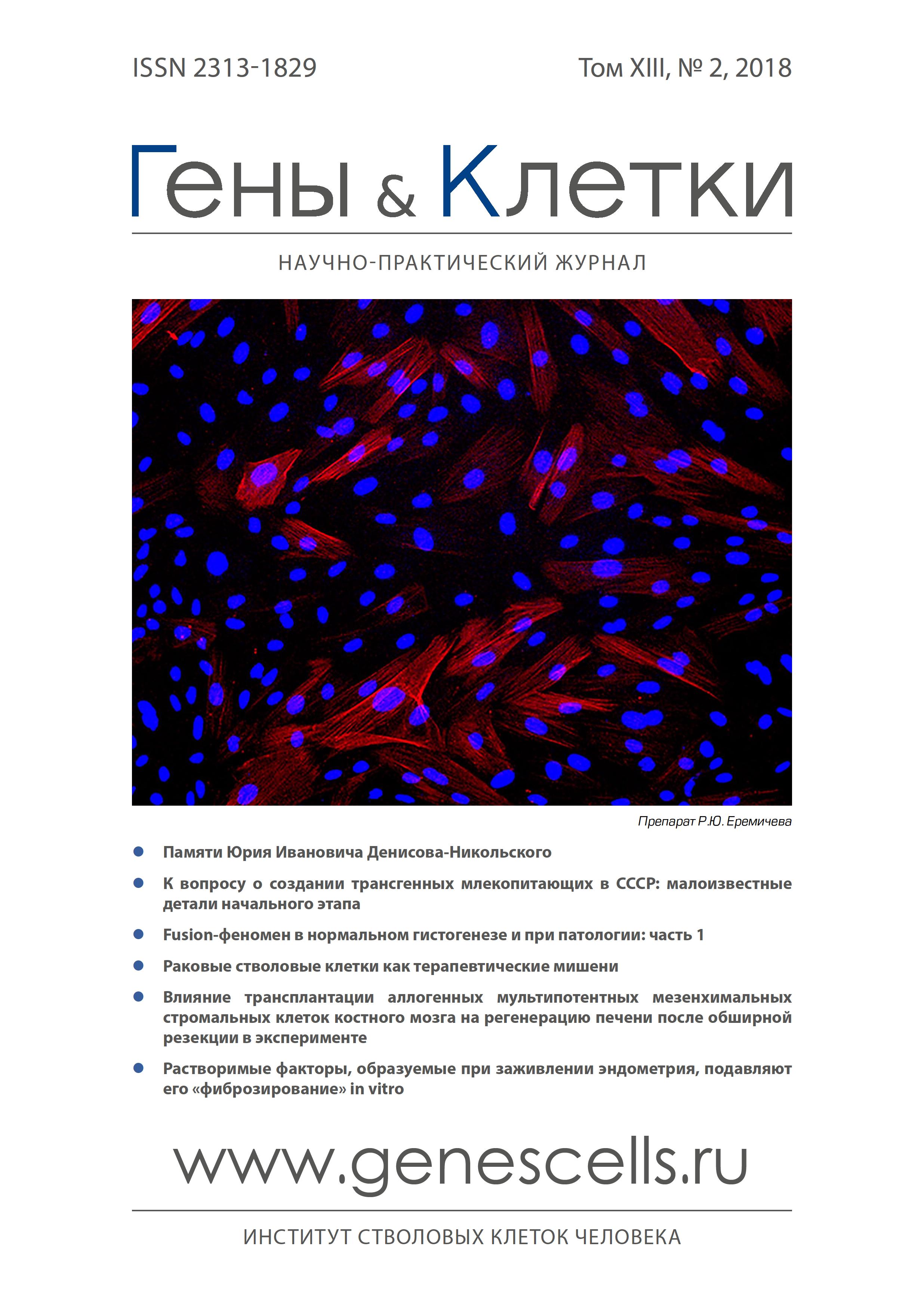Programmed necrosis and tissue regeneration
- Authors: Kopeina G.S1, Zamaraev A.V1, Zhivotovsky B.D1,2, Lavrik I.N1
-
Affiliations:
- M.V. Lomonosov Moscow State University
- Institute of Environmental Medicine, Karolinska Institute
- Issue: Vol 13, No 2 (2018)
- Pages: 35-38
- Section: Articles
- URL: https://genescells.ru/2313-1829/article/view/120720
- DOI: https://doi.org/10.23868/201808017
- ID: 120720
Cite item
Abstract
Programmed necrosis or necroptosis plays an important role in cell physiology. Disturbances in necroptotic process are associated with excessive cell death, the development of a number of pathological conditions, including inflammatory and neurodegenerative diseases. Accumulated evidences suggest the involvement of necroptosis in the induction of stem cell proliferation and tissue regeneration. The necrotic death can be triggered through the family of receptors of tumor necrosis factor, TRAILR1/2, FAS, as well as endosomal Toll-like and NOD-like receptors. An important role in the regulation of necroptosis belongs to proteins RIPK1 and RIPK3, which also might be essential for proliferation of stem cells and the regeneration process. Recent study has shown that necroptosis can lead to rapid activation of progenitor cells and regeneration of the hepatic tissues, as well as a necrotic-induced tissue regeneration and differentiation of c-kit+ cells in a model of myocardial infarction. Thus, the investigation of interplay between necroptosis and regeneration of damaged tissues will allow us to understand the fundamental aspects of programmed cell death and cell division.
Keywords
Full Text
About the authors
G. S Kopeina
M.V. Lomonosov Moscow State University
A. V Zamaraev
M.V. Lomonosov Moscow State University
B. D Zhivotovsky
M.V. Lomonosov Moscow State University; Institute of Environmental Medicine, Karolinska Institute
I. N Lavrik
M.V. Lomonosov Moscow State University
References
- Galluzzi L., Vitale I., Aaronson S.A. et al. Molecular mechanisms of cell death: recommendations of the Nomenclature Committee on Cell Death 2018. Cell Death Differ. 2018; 25(3): 486-541.
- Деев Р.В., Билялов А.И., Жампеисов Т.М. Современные представления о клеточной гибели. Гены и Клетки 2018; 13(1): 6-19.
- Zhou W., Yuan J. Necroptosis in health and diseases. Semin. Cell Dev. Biol. 2014; 35: 14-23.
- Wu W., Liu P., Li J. Necroptosis: An emerging form of programmed cell death. Crit. Rev. Oncol. Hematol. 2012; 82(3): 249-58.
- Linkermann A., Green D.R. Necroptosis. N. Engl. J. Med. 2014; 370(V): 455-65.
- Wilson N.S., Dixit V., Ashkenazi A. Death receptor signal transducers: nodes of coordination in immune signaling networks. Nat. Immunol. 2009; 10(4): 348-55.
- Hacker H., Karin M. Regulation and Function of IKK and IKK-Related Kinases. Sci. STKE 2006; 357: re13.
- Cho Y.S., Challa S., Moquin D. et al. Phosphorylation-Driven Assembly of the RIP1-RIP3 Complex Regulates Programmed Necrosis and Virus-Induced Inflammation. Cell 2009; 137(6): 1112-23.
- Moriwaki K., Chan F.K. RIP3: a molecular switch for necrosis and inflammation. Genes Dev. 2013; 27: 1640-9.
- Sun L., Wang H., Wang Z. et al. Mixed lineage kinase domain-like protein mediates necrosis signaling downstream of RIP3 kinase. Cell 2012; 148: 213-27.
- Murphy J.M., Czabotar P.E., Hildebrand J.M. et al. The pseudokinase MLKL mediates necroptosis via a molecular switch mechanism. Immunity 2013; 39: 443-53.
- Dondelinger Y., Declercq W., Montessuit S. et al. MLKL compromises plasma membrane integrity upon binding to phosphatidyl inositol phosphates. Cell Rep. 2014; 7: 1-11.
- Feoktistova M., Geserick P., Kellert B. et al. CIAPs Block Ripoptosome Formation, a RIP1/Caspase-8 Containing Intracellular Cell Death Complex Differentially Regulated by cFLIP Isoforms. Mol. Cell 2011; 43: 449-63.
- Tenev T., Bianchi K., Darding M. et al. The Ripoptosome, a Signaling Platform that Assembles in Response to Genotoxic Stress and Loss of IAPs. Mol. Cell 2011; 43: 432-48.
- Feoktistova M., Geserick P., Panayotova-Dimitrova D. et al. Pick your poison: The Ripoptosome, a cell death platform regulating apoptosis and necroptosis. Cell Cycle 2012; 11: 460-7.
- Craig C.E., Quaglia A., Selden C. et al. The Histopathology of Regeneration in Massive Hepatic Necrosis. Semin. Liver Dis. 2004; 24(1): 49-64.
- Weng H., Cai X., Yuan X. et al. Two sides of one coin: Massive hepatic necrosis and progenitor cell-mediated regeneration in acute liver failure. Front. Physiol. 2015; doi: 10.3389/fphys.2015.00178.
- Wang H., Sun L., Su L. et al. Mixed Lineage Kinase Domain-like Protein MLKL Causes Necrotic Membrane Disruption upon Phosphorylation by RIP3. Mol. Cell 2014; 54: 133-46.
- Ramachandran A., Mcgill M.R., Xie Y. et al. Receptor interacting protein kinase 3 is a critical early mediator of acetaminophen-induced hepatocyte necrosis in mice. Hepatology 2013; 58(6): 2099-108.
- Liu J., Wu P., Wang H. et al. Necroptosis Induced by Ad-HGF Activates Endogenous C-Kit+Cardiac Stem Cells and Promotes Cardiomyocyte Proliferation and Angiogenesis in the Infarcted Aged Heart. Cell. Physiol. Biochem. 2016; 40(5): 847-60.
- Habib А.А., Chatterjee S., Park S.K. et al. The epidermal growth factor receptor engages receptor interacting protein and nuclear factor-kappa B (NF-kappa B)-inducing kinase to activate NF-kappa B. Identification of a novel receptor-tyrosine kinase signalosome. J. Biol. Chem. 2001; 276(12): 8865-74.
- Park S., Zhao D., Hatanpaa K.J. et al. RIP1 activates PI3K-Akt via a dual mechanism involving NF-KB-mediated inhibition of the mTOR-S6K-IRS1 negative feedback loop and down-regulation of PTEN. Cancer Res. 2009; 69(10): 4107-11.
- Roderick J.E., Hermance N., Zelic M. et al. Hematopoietic RIPK1 deficiency results in bone marrow failure caused by apoptosis and RIPK3-medi-ated necroptosis. PNAS USA 2014; 111(40): 14436-41.
- Moriwaki K., Balaji S., McQuade T. et al. The Necroptosis Adaptor RIPK3 Promotes Injury-Induced Cytokine Expression and Tissue Repair. Immunity 2014; 41(4): 567-78.
- Moriwaki K., Balaji S., Bertin J. et al. Distinct Kinase-Independent Role of RIPK3 in CD11c+Mononuclear Phagocytes in Cytokine-Induced Tissue Repair. Cell Rep. 2017; 18(10): 2441-51.
- Zamaraev A.V., Kopeina G.S., Zhivotovsky B. et al. Cell death controlling complexes and their potential therapeutic role. Cell. Mol. Life Sci. 2015; 72(3): 505-17.
Supplementary files










